Author: Brian Hall
“Free range” has taken the food world by storm, but hops are one ingredient that might not benefit from the free-range treatment. Brewers making IPA often add massive amounts of hops to the kettle, and if those pellets are left to float free, they can drastically increase the amount of sediment in the wort at the end of the boil. To both prevent a clogged chiller and reduce the amount of trub going into the fermenter, some brewers resort to filtering their kettle hop additions, and one popular option of late is a stainless mesh basket colloquially referred to as a hop spider.
While wort easily flows through the fine mesh filter of a hop spider, it restrains the finest particulate from entering the kettle, ostensibly allowing the hops to impart all of the expected bitterness, flavor, and aroma without increasing the amount of kettle trub. However, some believe using such a device can affect beer quality by reducing the overall hop character, a concern that was seemingly validated by a past xBmt looking at how filtering kettle hops with fabric bags impacts beer.
I’ve been using a stainless hop spider in my brewing for the last several years with good results. Still, I’ve found myself thinking twice before making heavy hop additions to New England IPA, worried that the overcrowded hops wouldn’t produce the zing I was looking for. Not wanting to kneecap those heavenly flavors and aromas, I’ve often added whirlpool contributions in a separate spider out of concern not doing so my hinder my goal of maximum hop character. Curious if my approach was worth the effort, I designed an xBmt to test it out.
| PURPOSE |
To evaluate the differences between beers where kettle hops were added either to a stainless hop spider or directly to the boiling wort.
| METHODS |
I went with an IPA sans dry hop for this xBmt in an attempt to isolate the impact of using a stainless hop spider.
Slipper Check IPA
Recipe Details
| Batch Size | Boil Time | IBU | SRM | Est. OG | Est. FG | ABV |
|---|---|---|---|---|---|---|
| 5.5 gal | 60 min | 127.1 IBUs | 6.9 SRM | 1.062 | 1.012 | 6.6 % |
| Actuals | 1.062 | 1.01 | 6.9 % | |||
Fermentables
| Name | Amount | % |
|---|---|---|
| Lamonta American Style Pale Malt (Mecca Grade) | 13 lbs | 85.6 |
| Cara-Pils/Dextrine | 14 oz | 5.76 |
| Caramel/Crystal Malt - 40L | 5 oz | 2.06 |
| Corn Sugar (Dextrose) | 1 lbs | 6.58 |
Hops
| Name | Amount | Time | Use | Form | Alpha % |
|---|---|---|---|---|---|
| Columbus/Tomahawk/Zeus (CTZ) | 14 g | 60 min | Boil | Pellet | 13.1 |
| Warrior | 14 g | 60 min | Boil | Pellet | 13.8 |
| Columbus/Tomahawk/Zeus (CTZ) | 28 g | 45 min | Boil | Pellet | 13.1 |
| Simcoe | 28 g | 30 min | Boil | Pellet | 11.8 |
| Simcoe | 28 g | 1 min | Boil | Pellet | 11.8 |
| Centennial Hop Hash | 14 g | 1 min | Boil | Pellet | 18 |
| Columbus/Tomahawk/Zeus (CTZ) | 57 g | 5 min | Aroma | Pellet | 13.1 |
| Simcoe | 57 g | 5 min | Aroma | Pellet | 11.8 |
| Centennial Hop Hash | 5 g | 5 min | Aroma | Pellet | 18 |
Yeast
| Name | Lab | Attenuation | Temperature |
|---|---|---|---|
| Flagship (A07) | Imperial Yeast | 75% | 60°F - 72°F |
Notes
| Water Profile: Ca 117 | Mg 3 | Na 10 | SO4 84 | Cl 168 |
Download
| Download this recipe's BeerXML file |
Having collected RO water ahead of time, I started my brew day by warming up two identical volumes, which I adjusted to the same desired profile.
With the water on the burner, I weighed out and milled separate sets of grain.
Using the BIAB approach, I incorporated the grains into each batch before checking mash temperatures.
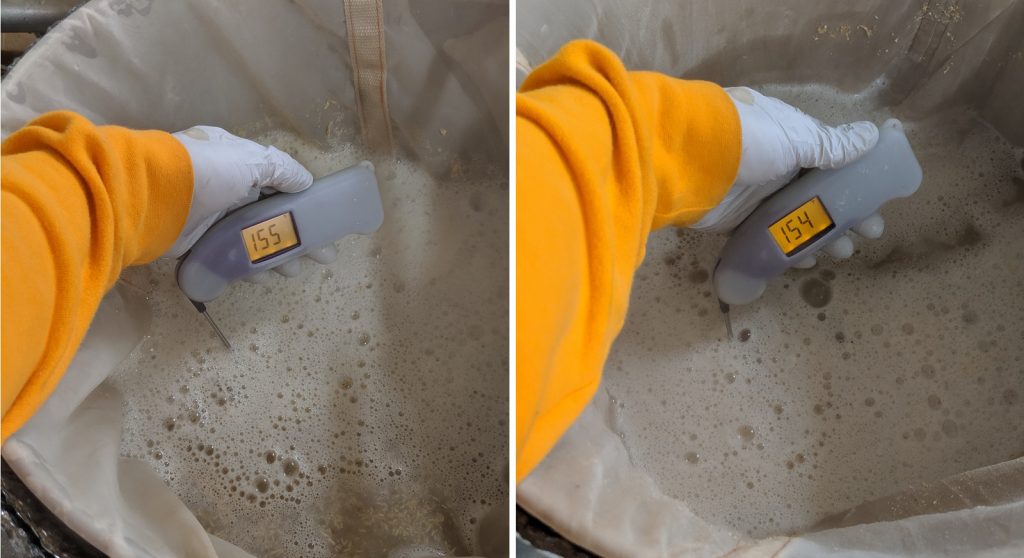
I wrapped each batch with insulation before leaving them alone to rest.
At the end of each mash step, the grain bags were hoisted out of the kettle and allowed to drip until the same pre-boil volume was reached.
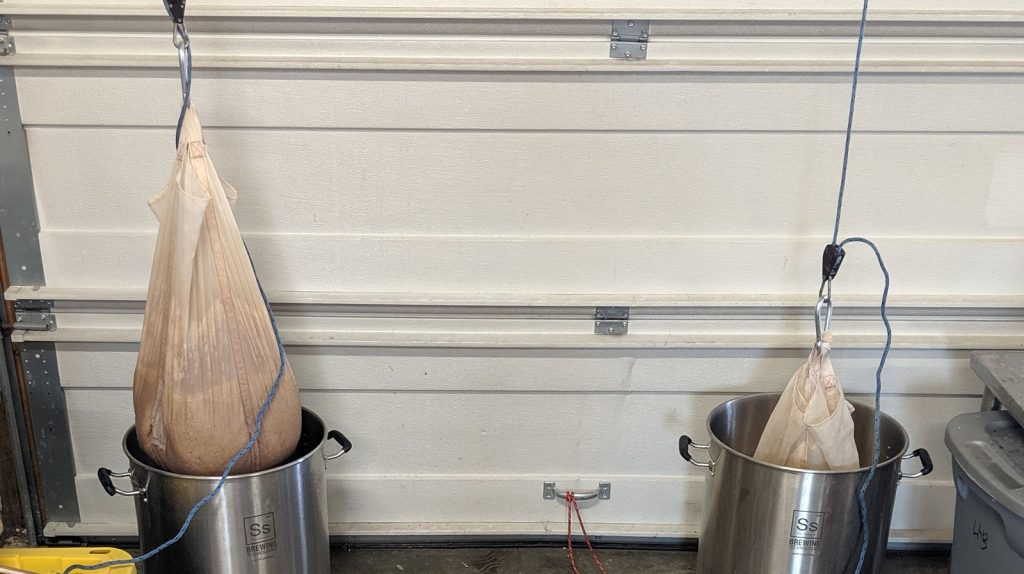
To ensure homogeneity, I combined the sweet wort from both batches and stirred thoroughly before splitting them equally.

While the worts were being heated, I measured out the kettle hop additions.
Both worts were boiled for 60 minutes with hops added at the same points, one set going into a stainless hop spider while the other was tossed directly into the wort.
When the boils were complete, I quickly chilled the wort.
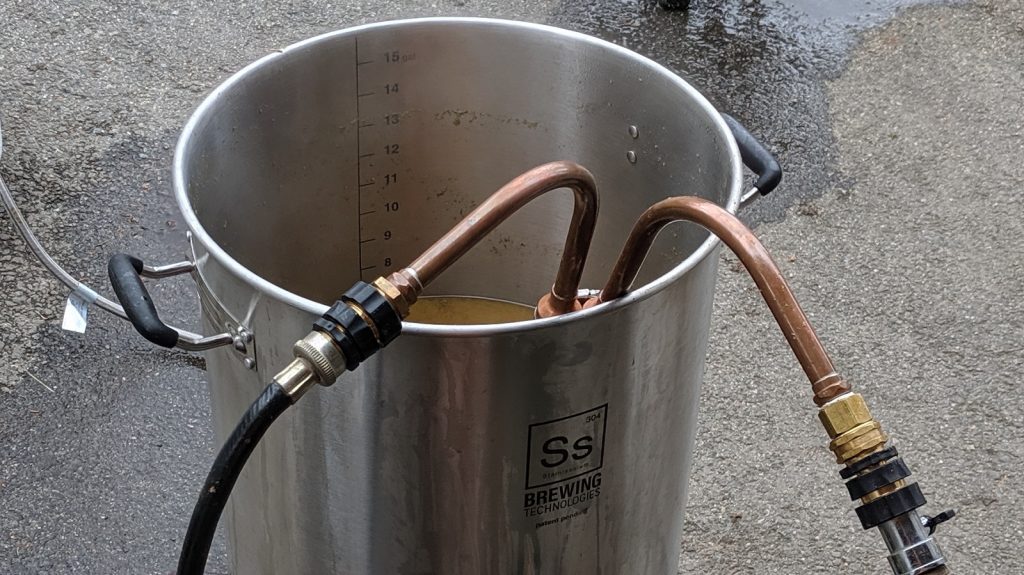
The difference in kettle trub appearance between the batches was rather stark.
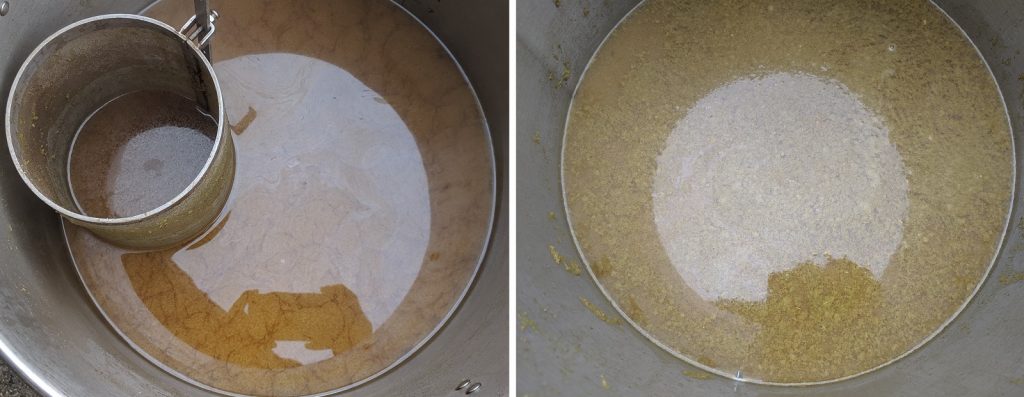
Wanting to keep the variable isolated, I made an effort to leave behind as much kettle trub as possible when racking to Brew Buckets.
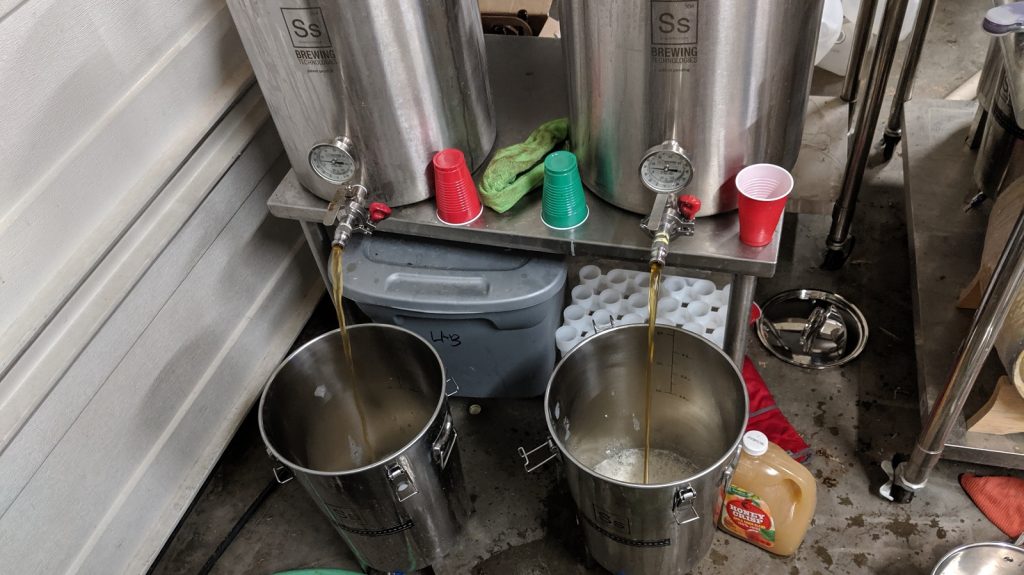
Hydrometer measurements showed both worts hit the same OG.
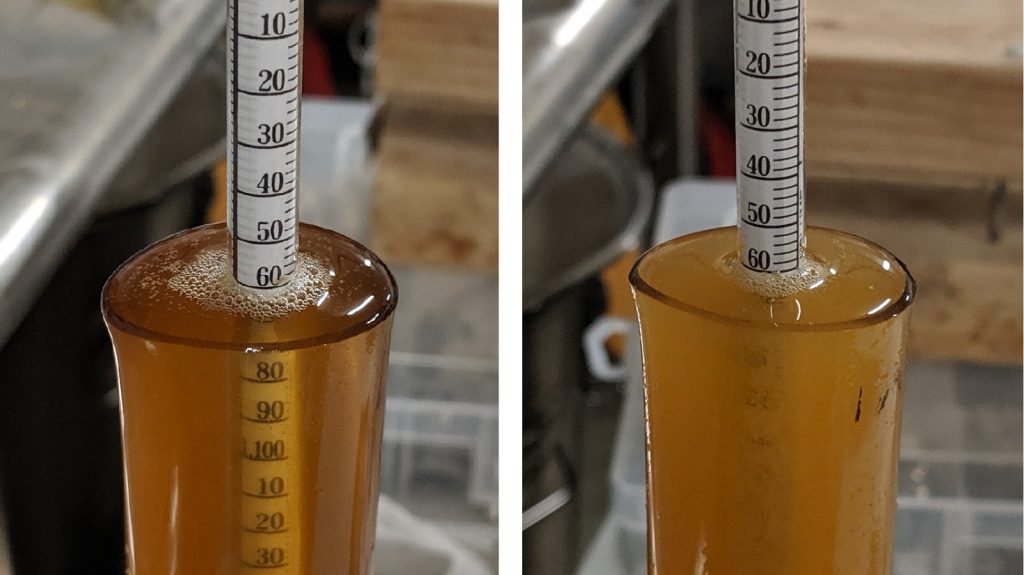
Each wort was then pitched with a single pouch of Imperial Yeast A07 Flagship.
The beers were left to ferment next to each other in a chamber controlled to 66°F/19°C for 16 days before I took hydrometer measurements showing a very minor difference in FG.
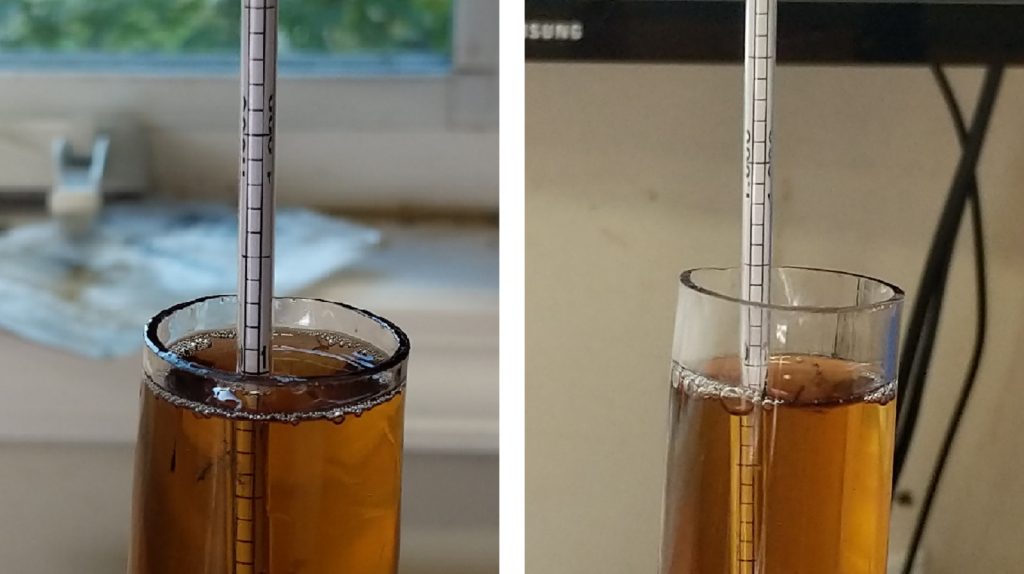
At this point, the beers were racked to separate CO2 purged kegs.
The filled kegs were placed in my keezer, burst carbonated, and left to condition for a couple weeks before I started serving them to tasters.
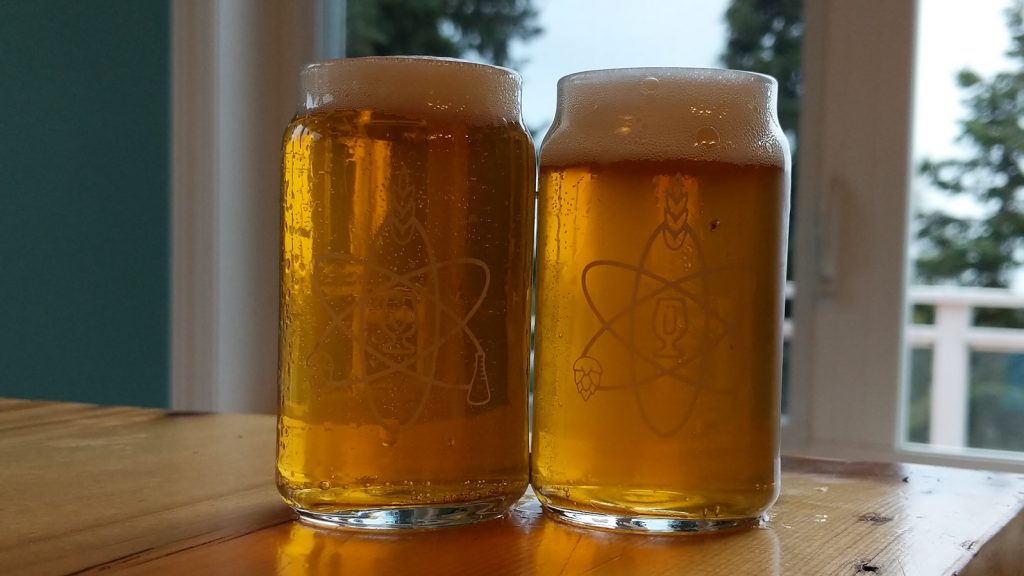
| RESULTS |
A total of 22 people of varying levels of experience participated in this xBmt. Each participant was served 1 sample of the beer made with hops added to a hop spider and 2 samples of the beer made with added loosely to the wort in different colored opaque cups then asked to identify the unique sample. While 12 tasters (p<0.05) would have had to accurately identify the unique sample in order to reach statistical significance, only 8 (p=0.46) did, indicating participants in this xBmt were unable to reliably distinguish a hoppy Pale Ale made with the kettle hops added to a hop spider from one where the hops are added directly to the boiling wort.
My Impressions: Out of multiple triangle test attempts, I was unable to reliably tell these beers apart, they were identical to me. I thought I had it nailed at one point, but subsequent attempts reminded me I had no idea what I was doing. The beer itself is great– bitter and flavorful without the huge caramel notes I feel make many examples of west coast IPA suck.
| DISCUSSION |
Clogged chillers are a huge pain, and previous xBmts have indicated that excessive trub might have an impact on the quality of finished beer, so it makes sense that brewers would want to contain their hops if doing so doesn’t have an impact on bitterness, aroma, and flavor. The fact tasters in this xBmt were unable to distinguish beers where the kettle hops were added either to a stainless mesh filter or directly to the wort suggests the impact wasn’t enough to create a perceptible difference.
Considering tasters from a previous xBmt were generally able to tell apart a beer where kettle hops were filtered with a fabric bag from one where the hops were added loosely, I’m left wondering if the material the filter is made of plays a role. Perhaps a stationary stainless mesh hop spider allows for better wort flow than fabric, which also seems to keep the hops more tightly contained.
For my part, I plan to continue using my hop spider. It’s easy to use, takes almost no time to rinse at the end of a brew day, and makes it a cinch to save yeast after fermentation since it reduces trub in the fermenter. If they don’t have an appreciable negative effect on bitterness or flavor, as the results of this xBmt seem to indicate, I really don’t see a downside.
If you have any thoughts about this xBmt, please do not hesitate to share in the comments section below!
Support Brülosophy In Style!
All designs are available in various colors and sizes on Amazon!
Follow Brülosophy on:
FACEBOOK | TWITTER | INSTAGRAM
If you enjoy this stuff and feel compelled to support Brulosophy.com, please check out the Support page for details on how you can very easily do so. Thanks!


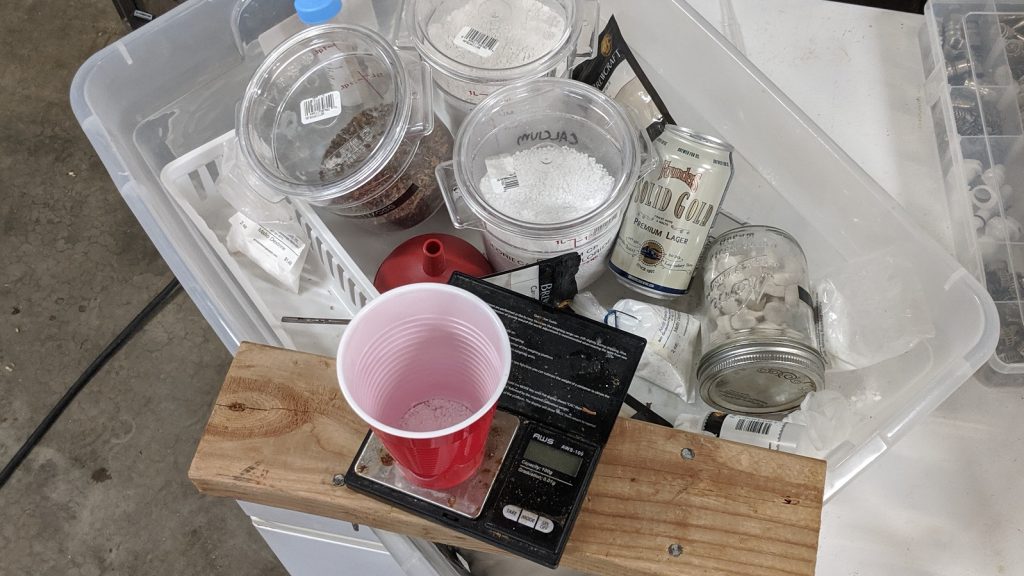
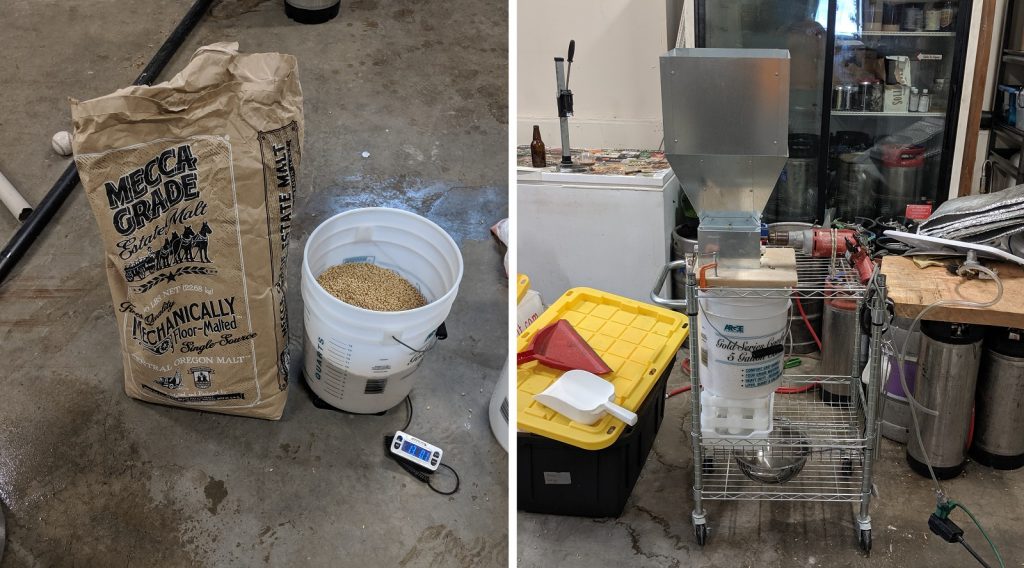



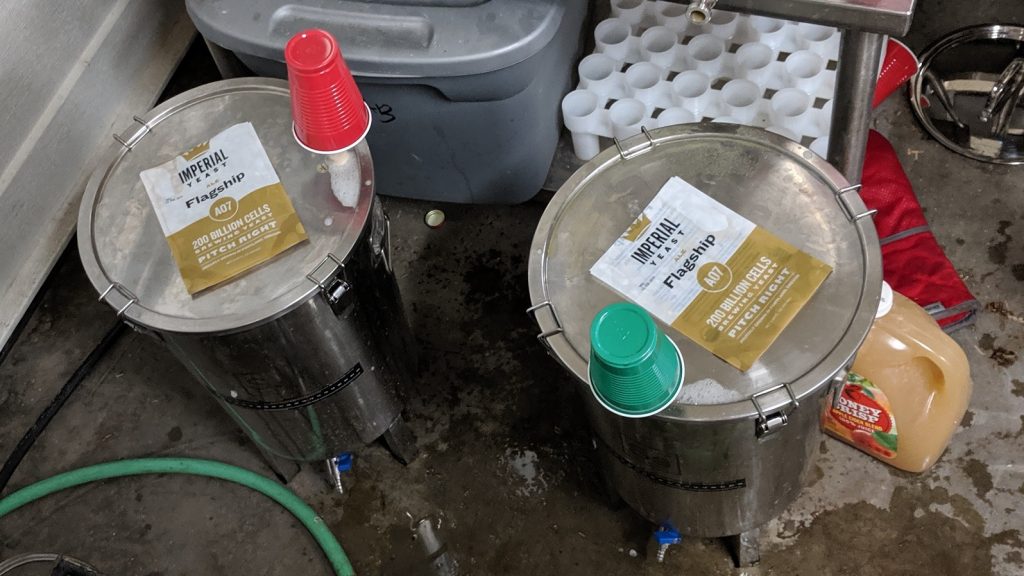
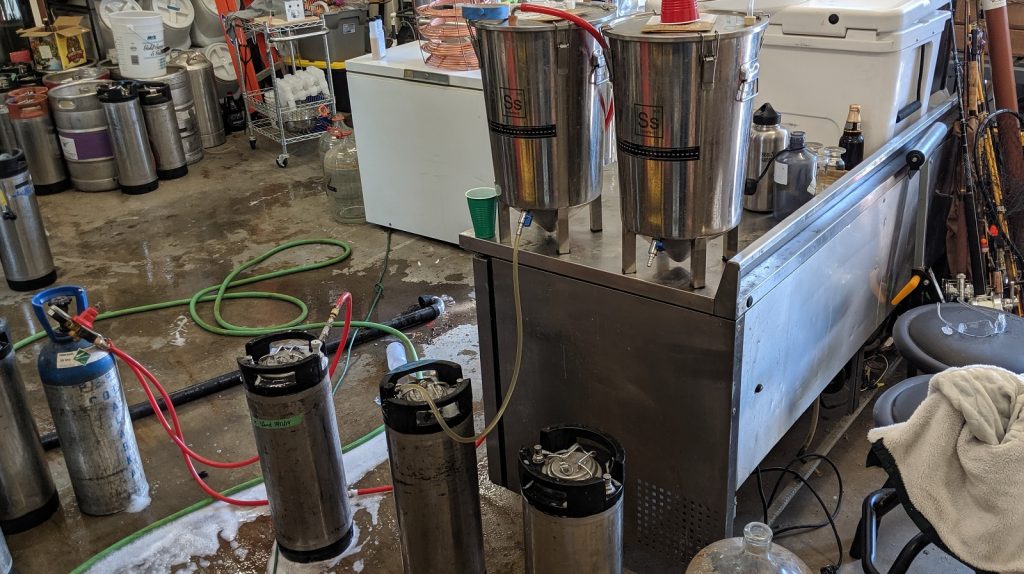










23 thoughts on “exBEERiment | Impact Filtering Kettle Hops With A Stainless Mesh Filter Has On An American IPA”
Was this an IPA or a Belgian Trippel?
I’m a loose hop man myself – I use a 20 gallon pot on my 5 gallon batches, and my stainless spider doesn’t reach all the way down the kettle. This experiment, taken the other way, suggests that works just as well. Thanks for doing it!
Great experiment! During the boil, did you stir the hops in the SS spider or just leave them alone. Do you know the micron size of your spider? Also, did all those (almost 9 oz.) hops fit comfortably in the spider?
I did stir several times, I stir all my batches every now and then. They all fit, it was tight. The goal was to really see how a LOT of hops would affect the outcome. 400 micron I believe.
English isn’t my first language but, as hard as I try, I can’t understand this: I designed a very simple Belgian Tripel recipe for this xBmt in hopes of emphasizing any impact of the variable, one receiving 10% sugar during the boil.
If it is supposed to be a tripel why is abc so pathetic? Which beer got the sugar and which didn’t? And how does changing up sugar help you answer the question about free or restrained hop pellets? I’ve been looking at this over and over again and still can’t figure it out. So confused!
You seem to use Imperial yeast all the time. I can’t get that where I buy my yeast, so if it isn’t an imposition could you please state what type of yeast it is that your using. you wouldn’t think a yeast for a Triple would be named Flagship, sounds more like maybe a chico,but who knows in this new yeast world we have today. English, Chico , Kolsch, it would be nice to know.
Flagship is Impreial’s Chico strain
Had you used a more reasonable amount of hops, the result may well have been quite different, as my experience using a stainless mesh hop spider was.
I found that my house IPA recipe with an OG of 1.063 and ~70 calculated IBUs (30 from the bittering addition) was noticeably less bitter when using the spider than just tossing the hops into the kettle. I used a total of 5 ounces in kettle additions and 3 ounces for dry hops. My spider is 300 micron mesh with a volume of one gallon. I will say that I really couldn’t tell the difference in flavor/aroma.
The IBU over 100 was my concern too. Does anyone have the distinguished palette to tell a lower % of IBU difference when the IBU’s are beyond what most would say is beyond what most people can discern. Thoughts?
What sort of analysis did you do for these beers? Side by side, triangle, or tetrad?
This is a beer I brew often with consistent results. I’m quite sure I can tell when something is different about it. Who better to perceive a difference in a beer than one who drinks it often?
I’ve noticed in the past that Brulosophy exbeeriments are conducted using recipes that are unlikely to obscure any differences caused by the variable. I don’t think this one even came close to doing that.
I can see wanting to pack a lot of hops into a given area to emphasize the point of the experiment, but really think that raising the level of the spider and using less hops would have accomplished the same thing while keeping the bitterness level in the realm of normality.
Just my opinion. I do love what you guys do.
So how much wort was ‘saved’ by not having all the hop sediment in the bottom of the fermenter?
I ran both worts through the same screen so as to have equal trub in the fermenter to keep the boiling variable isolated.
Nice experiment. Really appreciate you held back the dry hop to try to isolate the variable. Also nice to see a west coast IPA with a wrecking level IBUs.
I suppose you might not get criticism that with all those IBUs the delicate hop flavors would not be perceptible no doubt you made a hop forward beer and people couldn’t tell them apart.
I am curious about the volumes. Did use of the hop spider result in more or less beer reaching the keg?
Also how about the clarity? Did the hop spider beer stay clearer than the other one?
I think this experiment will need revisiting. The error here is in the recipe chosen for the experiment. At 127 IBUs, there’s no way anyone would be able to discern any minor differences. The only flavor is bitter at such a high level. Humans can’t distinguish any more bitterness past 80IBUs. That said, if you were to have chosen something not quite so hoppy, like an American pale ale, you might have different results. I’ve noticed drastic differences in less hopped beers with my spider vs hop bag.
Try it out and share the results with us! Have you checked out the Bru Club?
I doubt there was actually “127 IBU”. Probably closer to 80-90 by the time the samples were served.
It would appear something is wrong with the IBU calculations in the recipe. The IBUs listed for the 1 minute and aroma (whirlpool?) additions look extremely high for the amount of hops added.
Was there enough room in your kettle for both the hop spider and the Hydra? Wondering how I’d go about sanitizing my Hydra near the end of the boil in my 10 gallon kettle. Thanks!
My spider has given me cleaning frustrations, as its difficult to get the mesh clean after brewing. You state yours is cleaned easily — do you have any tips on this?
Hose it out. Upside down, hose the outside, very quick and easy.
I clean mine with a pressure washer which I also use to clean the patio. Keeps SWMBO happy.
Thanks. Your result is comforting because my hop spider is a valuable player in my brew day. Clean up is easier, and I skip the whirlpool altogether. I would expect your result because, and I’m not an expert, getting the bitterness from hops is due to temperature and time. (https://beerandbrewing.com/dictionary/hLffCRjWv0/, “Isomerization is the result of the effect of heat on the alpha acids. The process is both time and temperature dependent.”). It seems your experiment confirms that the freedom of small hop particles to clog up the hosing downstream from the kettle or to be added into the fermenter has little effect.
I know this is a late addition to this thread but I thought it might be useful for others. I have been trying to identify the cause of my reduced BIAB bitterness. At first I thought it might be excess proteins dragging hop acids out during the boil. However, I made an effort of monitoring the temperatures in and outside of my hop spider this week and found that the temperature of the wort in the spider was consistently 96.5 degrees C vs 100+ in the rest of the kettle. This corresponds to something like a 25% reduction in hop utilisation judging by resources I have found online. I tried to compensate for this by increasing my 30 minute hop addition and time will tell as to whether that worked. I use an induction hob that gives me 2900 watts on my 230V supply so I wonder if the choice of heating governs the temperature in the spider. Reminds me that one variable on its own may not impact your beer but if one combines a number of factors such as induction hob, BIAB and a hop spider then perhaps there could be an impact.